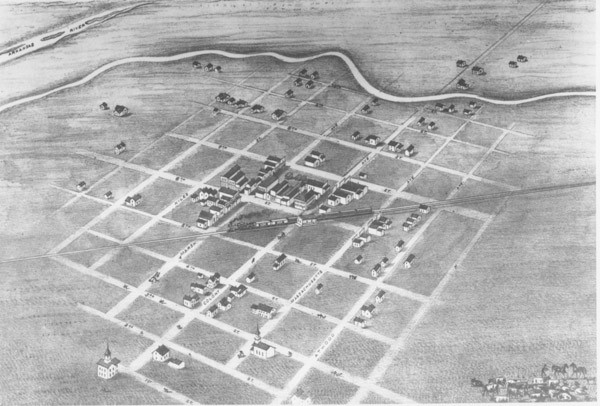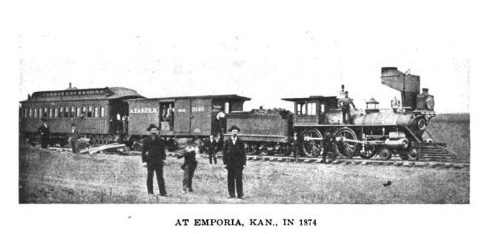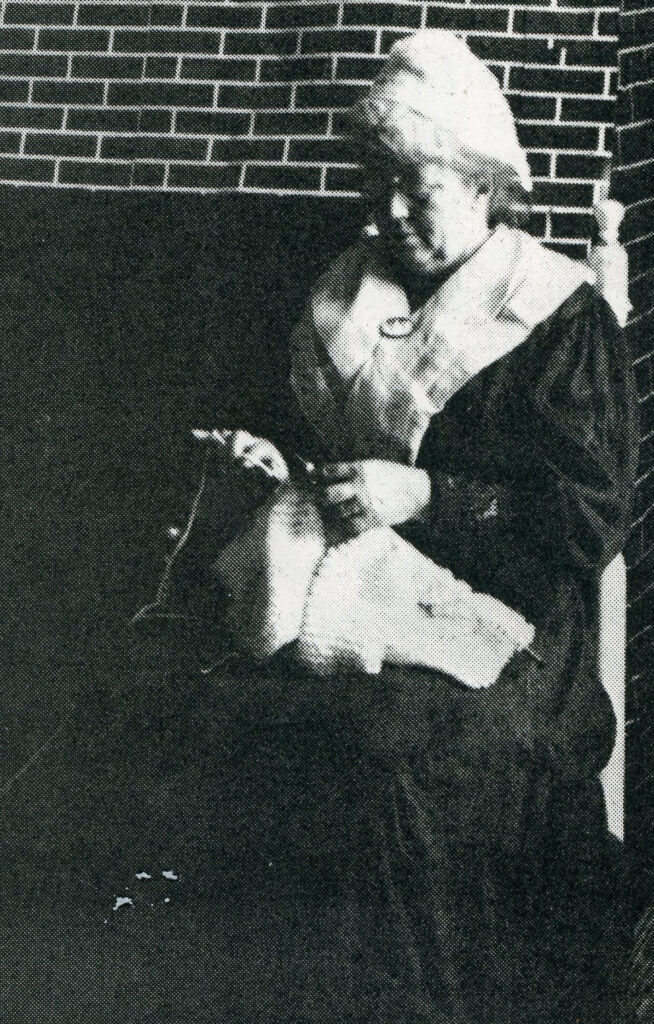I’m back at the computer to write something to commemorate Kinsley’s sesquicentennial which will be celebrated over Labor Day weekend along with the All School Reunion. I was led to thinking about how people came to Kinsley. Back in my elementary school days, we learned of the hearty pioneers trekking west in their Conestoga wagons. Some homesteaders came with their belongings to Edwards County in that manner. However, the reason for Kinsley to be located where it is was due to the location of the Atchison, Topeka, and Santa Fe Railroad which reached here on August 1, 1872. Many more people arrived by train.
J. A. Walker was one of the original members of the “Massachusetts colony” which decided to settle here. This location was just a station on the newly built railroad known as Petersburg (also Peters, Peters City, Peter’s Point). He wrote in 1873, “The location is a desirable one; the valley averages about four miles width, all on the north side of the river, the great Arkansas River….” He goes on to describe the soil and easily accessible “drive wells costing about one dollar per foot inclusive of pump and pipe.”

One of the members of the original Massachusetts colony was Captain Nicholas L. Humphrey (1810-1885). He had been a boat captain and merchant in Maine until he came west seeking relief for his asthma. Captain Humphrey came to Kinsley on the train in April, 1873.
Early traveling on the ATSF was not comfortable. Steam engines averaged about 20 mph, and they stopped regularly for water. They belched smoke and stirred up dust. Passengers cars had wooden benches; some travelers rode with their animals in the freight cars. There was no dining car or set time schedule; it would not be until 1878 when the railroads would establish the time zones to make train scheduling possible. Except for a quick whistle and the “all Aboard” cry, there was no warning of a train’s departure, resulting in passengers jumping onto moving cars.

Humphrey built a clapboard home two miles north of Kinsley (on the west side of 90th, between K and J Roads, farm ground now). Humphrey “was much better off than many of his neighbors…. his home was one of the best built in Edwards County. The lumber was shipped from Emporia and between the walls was a sheeting of building paper, a protection against the cold…” (A Standard History of Kansas and Kansans)
Once the house was built, Humphrey’s wife joined him, and then they sent for their daughters: Fannie, Harriet, and Alice. The young ladies traveled by train for six days, coming from Boston to Chicago, to Atchison, Emporia, Newton and west to Kinsley. They arrived on Friday, November 28, 1873.
Fourteen year old daughter, Alice (Alice Loring Humphrey Erwin) remembered the journey later: “It is thirty odd years since I left my faraway New England home, and it seems but a wave of a hand, so distinctly do I remember when we stepped from the creaking, groaning old cars (for you must bear in mind that the train service on the Santa Fe was quite different in 1873 from that in 1905.”
She continued: “We made our way to the roughly constructed hotel, unplastered and dimly lighted, the odor of pancakes filling the air. (Buffalo House, 514 Massachusetts Ave. was a meal stop for the train.) But we received a cordial welcome from the landlady, as our coming was not unexpected. My father and mother had proceeded my two older sisters and myself some months….”
“Never shall I forget that first sunrise, not a tree or a house to obstruct the view or to prevent our seeing the first peep Old Sol took of us as he rose, so far away, over the long stretch of prairies so new to us, and when he burst forth in all his glory there was a feeling of newness and freshness pervading everything.
“As we looked out toward the north we saw a speck which was coming nearer and growing larger. It proved to be our father with the farm wagon.”
Her older sister, Hattie Harriet Humphrey (1852-1945), also wrote about the arrival in her diary. “We arrived at our new home this morning before sunrise. The landlady at the hotel (Mrs. Clute) was very cordial. We had a cold ride from the cars. Saw the sun rise; it was a beautiful sight. Homesick, but not sorry we came. Our house consists of two very large unfurnished rooms, one upstairs, one downstairs; hope we shall not always live here. There is not a tree to be seen in the vicinity. I am very, very thankful that we are all together once more.
Mr. Humphrey would prove up his homestead and was elected county treasurer and the county clerk. His asthma forced him to move to the mountain climate of Pueblo, Colorado.
Alice would marry William Erwin, have 6 childrenand lived at 412 E Seventh St. She was a poet and very active in the community. She died at age 85.

